IAU adopts World Athletics shoe rules for ultramarathons
Many ultra records could be in jeopardy following the latest news from the International Association of Ultrarunners

On Friday, the International Association of Ultrarunners (IAU) announced that it has adopted the latest World Athletics (WA) shoe rules, but with one difference: ultrarunners will be permitted to wear shoes with stack heights of up to 40 mm on any surface, whether on the trails, roads or track. That means that, unlike athletes under the WA umbrella, ultrarunners will be able to wear the tallest legal road running shoes in track races. This decision from the IAU could lead to many broken records in ultramarathons, specifically those that are run on the track, such as 24- or 48-hour races.
World Athletics Shoes Regulation – application to Ultradistance
More info at IAU Websitehttps://t.co/QtF2qLcAYM— IAU (@iaunews) October 30, 2020
Ultramarathon stack height
As written in the IAU announcement, “World Athletics Technical Rule 5 should be followed in all IAU MIAUC [Major IAU Competition] events with the only exception that athletes can use shoes under ‘Road Events’ specification independently of the surface where races are taking part.” This means athletes can follow the road running rules set forth by WA for any ultramarathons, whether they’re on trails, roads or tracks.
RELATED: World Athletics bans prototypes from elite competition
There’s a big difference between maximum stack height for shoes in track races versus road races, and this will give ultrarunners a big advantage when they take to the track. For road races, the maximum stack height under the WA rules is 40 mm. On the track, though, the maximum is much less, coming in at just 25 mm. Since the IAU has said road rules apply independent of surface, athletes will be able to race in shoes with a 40 mm stack height even when they’re racing on a track, which will massively benefit ultrarunners.

A level playing field
Rule 5 also notes that any “type of shoe must be reasonably available to all in the spirit of the universality of athletics.” This means a company cannot design a shoe that will only be given to one athlete. A shoe can certainly be designed with an athlete in mind, but in order for that athlete to be able to use it in competition, the shoe must be put on the market and made available to anyone.
RELATED: Runners push back against new World Athletics shoe rules
Further, it’s stated that a shoe “may be customized to suit the characteristic of a particular athlete’s foot … [but] one-off shoes made to order (i.e. that are only ones of their kind) to suit the characteristics of an athlete’s foot or other requirements are not permitted.” An individual can make custom changes to their shoes, but they can’t have a one-of-a-kind shoe all to themselves.


